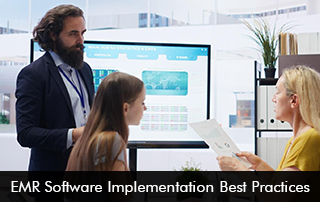EMR software has become an indispensable tool in modern healthcare, transforming how medical practices operate and deliver patient care. Electronic Medical Record (EMR) software digitize patient records, streamline workflows, and enhance communication among healthcare providers, ultimately leading to improved patient outcomes and operational efficiency
The Critical Role of Best Practices in EMR Software Implementation
Implementing EMR software is a complex process that requires careful planning and execution. Best practices are essential to avoid errors, prevent data corruption, and ensure a smooth transition from paper-based records to digital systems. By following established guidelines, healthcare organizations can minimize disruptions to their operations, protect patient data integrity, and maximize the benefits of their EMR investment.
EMR Software Implementation Best Practices
1. Conduct a Thorough Needs Assessment
Before selecting an EMR system, perform a comprehensive analysis of your practice’s specific requirements. Consider factors such as:
- Practice size and specialty
- Current workflows and pain points
- Integration needs with existing systems
- Budget constraints
- Regulatory compliance requirements
This assessment will help you choose an EMR solution that aligns with your practice’s unique needs and goals.
2. Secure Leadership Buy-In and Form a Dedicated Implementation Team
Ensure that leadership fully supports the EMR implementation project. Form a dedicated team comprising representatives from various departments, including clinical staff, IT, and administration. This team will oversee the implementation process, make critical decisions, and serve as champions for the new system.
3. Develop a Comprehensive EMR Software Implementation Plan
Create a detailed plan that outlines:
- Project timeline and milestones
- Resource allocation
- Training schedules
- Data migration strategy
- Testing and quality assurance procedures
- Go-live date and contingency plans
A well-structured plan will help keep the implementation on track and ensure all aspects of the transition are addressed.
4. Prioritize Data Migration and Integrity
Develop a robust strategy for migrating existing patient data to the new EMR system. This process should include:
- Data cleaning and standardization
- Validation of migrated data
- Establishing protocols for handling incomplete or inconsistent records
Ensuring data integrity during migration is crucial for maintaining continuity of care and avoiding potential legal issues.
5. Customize the EMR Software to Fit Your Workflow
Work closely with the EMR vendor to customize the system to match your practice’s existing workflows. This may involve:
- Creating custom templates and forms
- Configuring user roles and permissions
- Setting up automated alerts and reminders
Tailoring the EMR to your specific needs will improve user adoption and maximize efficiency gains.
6. Provide Comprehensive Training and Support
Invest in thorough training for all staff members who will use the EMR system. This should include:
- Role-specific training sessions
- Hands-on practice with the system
- Documentation of standard operating procedures
- Ongoing support and refresher courses
Well-trained staff are more likely to use the EMR effectively and realize its full potential.
7. Implement Robust EMR Software Security Measures
Protect patient data and ensure compliance with regulations like HIPAA by implementing strong security measures, including:
- Multi-factor authentication
- Role-based access controls
- Regular security audits
- Encryption of data at rest and in transit
Prioritizing security will help maintain patient trust and avoid costly data breaches.
8. Establish a Quality Assurance Process
Develop a systematic approach to monitoring and improving the quality of data entered into the software. This may involve:
- Regular audits of patient records
- Automated data validation checks
- Peer review processes for clinical documentation
Maintaining high data quality is essential for accurate reporting, clinical decision-making, and patient safety.
Implementing EMR Software Best Practices Seamlessly and Efficiently
To ensure a smooth implementation of these best practices, consider the following strategies:
1. Phased Implementation Approach
Rather than attempting a full-scale rollout all at once, consider implementing the EMR system in phases. This approach allows you to:
- Address issues and refine processes on a smaller scale
- Build confidence and momentum among staff
- Minimize disruptions to patient care
Start with a pilot group or department, then gradually expand to other areas of the practice.
2. EMR Software Leverage Super Users
Identify and train a group of “super users” who can serve as on-site experts and champions for the EMR system. These individuals can:
- Provide peer-to-peer support
- Help troubleshoot issues
- Gather feedback for continuous improvement
Super users play a crucial role in driving adoption and addressing concerns at the ground level.
3. Establish Clear Communication Channels
Maintain open lines of communication throughout the implementation process. This includes:
- Regular updates to all staff members
- A dedicated helpdesk or support system
- Feedback mechanisms for users to report issues or suggest improvements
Clear communication helps manage expectations and address concerns promptly.
4. Monitor Key Performance Indicators (KPIs)
Define and track KPIs to measure the success of your EMR implementation. These may include:
- User adoption rates
- Time savings in documentation
- Reduction in medical errors
- Improvement in billing accuracy
Regularly reviewing these metrics allows you to identify areas for improvement and demonstrate the ROI of your EMR investment.
5. Continuously Optimize and Improve EMR Software
Treat EMR implementation as an ongoing process rather than a one-time event. Regularly:
- Solicit feedback from users
- Stay updated on new features and updates from your EMR vendor
- Refine workflows and processes based on real-world usage
This approach ensures that your EMR software continues to meet the evolving needs of your practice.








